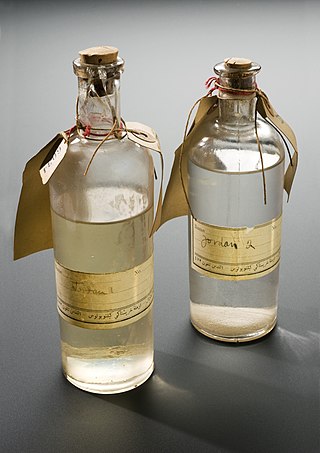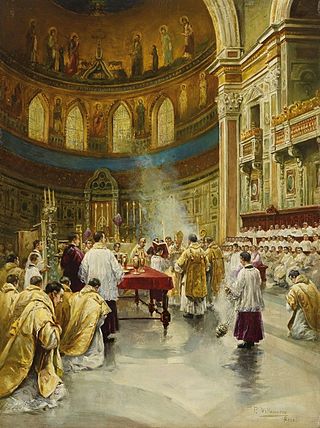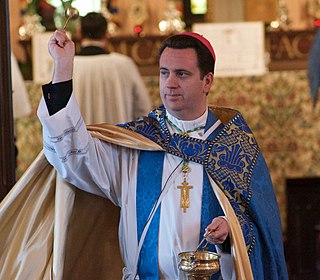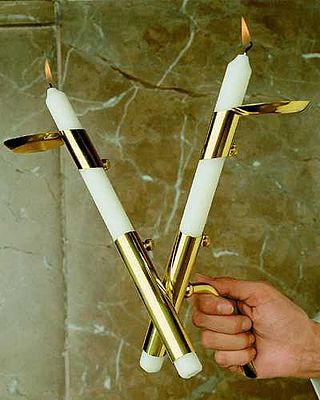
Anointing is the ritual act of pouring aromatic oil over a person's head or entire body.
Mainline Christian theology has traditionally held that only one baptism is valid to confer the benefits of this sacrament. Therefore, in cases where the validity of a baptism is in doubt, a conditional baptism may be performed. There exist other conditional sacraments.
In some religions, an exorcist is a person who is believed to be able to cast out the devil or performs the ridding of demons or other supernatural beings who are alleged to have possessed a person, or (sometimes) a building or even an object. An exorcist can be a specially prepared or instructed person including: priest, a nun, a monk, a witch doctor (healer), a shaman, a psychic or a geomancer.

Making the sign of the cross, or blessing oneself or crossing oneself, is a ritual blessing made by members of some branches of Christianity. This blessing is made by the tracing of an upright cross or + across the body with the right hand, often accompanied by spoken or mental recitation of the Trinitarian formula: "In the name of the Father, and of the Son, and of the Holy Spirit. Amen."

Holy water is water that has been blessed by a member of the clergy or a religious figure, or derived from a well or spring considered holy. The use for cleansing prior to a baptism and spiritual cleansing is common in several religions, from Christianity to Sikhism. The use of holy water as a sacramental for protection against evil is common among Lutherans, Anglicans, Roman Catholics, and Eastern Christians.

A sacramental is a sacred sign, a ritual act or a ceremony. which, in a certain imitation of the sacraments, has a spiritual effect and is obtained through the intercession of the Church. Sacramentals surround the sacraments like a wreath and extend them into the everyday life of Christians. Sacramentals are recognised by the Roman Catholic Church, the Eastern Orthodox Church, the Oriental Orthodox Churches, the Church of the East, the Lutheran churches, the Old Catholic Church, the Anglican churches, Independent Catholic churches, and Methodist churches.
The Litany of the Saints is a formal prayer of the Roman Catholic Church as well as the Old Catholic Church, Anglo-Catholic communities, and Western Rite Orthodox communities. It is a prayer to the Triune God, which also includes invocations for the intercession of the Blessed Virgin Mary, the Angels and all the martyrs and saints upon whom Christianity was founded, and those recognised as saints through the subsequent history of the church. Following the invocation of the saints, the Litany concludes with a series of supplications to God to hear the prayers of the worshippers. It is most prominently sung during the Easter Vigil, All Saints' Day, and in the liturgy for conferring Holy Orders, the Consecration of a Virgin and reception of the perpetual vows of a religious or a diocesane hermit.
The Roman Ritual is one of the official liturgical books of the Roman Rite of the Latin Church of the Catholic Church. It contains all of the services that a priest or deacon may perform; and are not contained in the Missale Romanum, Pontificale Romanum, or Caeremoniale Episcoporum, but for convenience does include some rituals that one of these books contains.

The Chrism Mass is a religious service held in certain Christian denominations, such as Roman Catholicism, Lutheranism, and Anglicanism. It is usually celebrated each year on Maundy Thursday or on another day of Holy Week. During the ceremony, the holy oils used for sacraments and rituals are blessed or consecrated.

Asperges is the rite of sprinkling a congregation with holy water. The name comes from the first word in the 9th verse of Psalm 51 in the Latin translation which is sung during the traditional form of the rite except during Eastertide. The 51st Psalm is also one of the antiphons that may be sung in the rite under the Mass of Paul VI.

Catechesis is basic Christian religious education of children and adults, often from a catechism book. It started as education of converts to Christianity, but as the religion became institutionalized, catechesis was used for education of members who had been baptized as infants. As defined in the Catechism of the Catholic Church, paragraph 5 :
Catechesis is an education in the faith of children, young people and adults which includes especially the teaching of Christian doctrine imparted, generally speaking, in an organic and systematic way, with a view to initiating the hearers into the fullness of Christian life.

In Christian tradition the churching of women, also known as thanksgiving for the birth or adoption of a child, is the ceremony wherein a blessing is given to mothers after recovery from childbirth. The ceremony includes thanksgiving for the woman's survival of childbirth, and is performed even when the child is stillborn, or has died unbaptized.
In keeping with its prevailing self-identity as a via media or "middle path" of Western Christianity, Anglican sacramental theology expresses elements in keeping with its status as a church in the catholic tradition and a church of the Reformation. With respect to sacramental theology the Catholic tradition is perhaps most strongly asserted in the importance Anglicanism places on the sacraments as a means of grace, sanctification and forgiveness as expressed in the church's liturgy.

The Oil of Catechumens, also known as the Oil of Exorcism, is the oil used in some traditional Christian churches during baptism; it is believed to strengthen the one being baptized to turn away from evil, temptation and sin.

The Euchologion is one of the chief liturgical books of the Eastern Orthodox and Byzantine Catholic churches, containing the portions of the services which are said by the bishop, priest, or deacon. The Euchologion roughly corresponds to a combination of the missal, ritual, and pontifical as they are used in Latin liturgical rites. There are several different volumes of the book in use.

The Blessing of the Throats is a sacramental of the Roman Catholic Church, ordinarily celebrated on February 3, the feast day of Saint Blaise of Sebaste. It is also celebrated in some of the Eastern Catholic Churches, and in parishes of the Anglican Communion on the same day as a commemoration.

Among Eastern Orthodox and Eastern-Rite Catholic Christians, holy water is blessed in the church and given to the faithful to drink at home when needed and to bless their homes. In the weeks following the Feast of Epiphany, clergy visit the homes of parishioners and conduct a service of blessing using the holy water that was blessed on the Feast of Theophany. For baptism, the water is sanctified with a special blessing.

The Order of Christian Initiation of Adults (OCIA), or Ordo Initiationis Christianae Adultorum, is a process developed by the Catholic Church for its catechumenate for prospective converts to the Catholic faith above the age of infant baptism. Candidates are gradually introduced to aspects of Catholic beliefs and practices. The basic process applies to adults and children who have reached catechetical age. Previously, the Order of Christian Initiation of Adults was known as the Rite of Christian Initiation of Adults (RCIA). The name was changed in 2021 to reflect greater fidelity to the original Latin.

The expression minor exorcism can be used in a technical sense or a general sense. The general sense indicates any exorcism which is not a solemn exorcism of a person believed to be possessed, including various forms of deliverance ministry. This article deals only with the technical sense which specifically refers to certain prayers used with persons preparing to become baptised members of the churches which makes use of such rites. These prayers request God's assistance so that the person to be baptised will be kept safe from the power of Satan or protected in a more general way from temptation.

Easter Water is the name given to water used in rituals during the Easter Vigil in the Catholic Church, Lutheran Churches, and Anglican Communion. A part of this water is set aside for use as a sacramental in the church and at home, the remainder being ceremonially mixed with consecrated oils and used for baptisms in the church.















